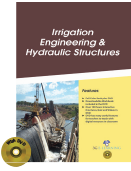Engineering and Technology

Irrigation is the practice of arti cially applying water to otherwise dry land during summer. Gardeners use hoses and sprinklers to water owerbeds, vegetable gardens and lawns. This is irrigation at its most basic. Large scale irrigation is where market gardeners, farmers, orchardists and grape growers apply water at critical times to assist plant growth and therefore produce quality crops. Irrigation water can come from nearby rivers or under-ground water (groundwater) or storage ponds speci cally designed to collect high river ows during winter. Pipes, channels and wells dug into the ground allow water to be taken from its source to the farms, vineyards and orchards where it will be used. Today a diverse range of ever-evolving technologies exist to e ciently apply irrigation water to crops. How much water is used depends on the type of crop, the soil in which the crop is being grown and the amount of rainfall in that area. Hydraulic design involves the application of ow theory to the design of various water containment and control structures. The designer should ensure that the structure and the systems will function e ectively and economically under all foreseeable service conditions. Hydraulic structures must be capable of withstanding ow conditions and forces caused by both static and owing water loading. They must be so designed as to last over their design life span and be resistant to deterioration, aging, and extemporaneous forces due to weather extremes and earthquakes. In designing a hydraulic structure, the designer chooses from many options available, and from past experience, that particular design believed to be the most cost-e ective, functional, and safe.